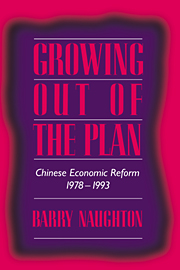Book contents
- Frontmatter
- Contents
- Tables and figures
- Preface
- Introductory
- Phase one The bird in the cage, 1979–1983
- Phase two Reforms take off, 1984–1988
- 5 Reformulation and debate: The turning point of 1984
- 6 The second phase of reform, 1984–1988
- 7 Rapid growth and macroeconomic imbalance
- Phase three To a market economy
- Statistical appendix
- Notes
- Bibliography
- Index
7 - Rapid growth and macroeconomic imbalance
Published online by Cambridge University Press: 03 May 2010
- Frontmatter
- Contents
- Tables and figures
- Preface
- Introductory
- Phase one The bird in the cage, 1979–1983
- Phase two Reforms take off, 1984–1988
- 5 Reformulation and debate: The turning point of 1984
- 6 The second phase of reform, 1984–1988
- 7 Rapid growth and macroeconomic imbalance
- Phase three To a market economy
- Statistical appendix
- Notes
- Bibliography
- Index
Summary
Along with the shift in reform strategy, China's macroeconomic policy regime also shifted sharply during 1984. Credit policy became much more expansionary – the rate of credit creation doubled – and monetary instability also increased. Expansionary monetary policy let to rapid growth of demand and an acceleration in economic growth. An extended economic boom, particularly in industry, unfolded through the mid and late 1980s. Economic growth interacted with reforms to create rapid structural change, and the Chinese economy became more diverse, more open, and much bigger. But sustained expansionary policy gradually but inexorably led to inflation. Accumulating inflationary pressures erupted during 1988 in a burst of high open inflation. Austerity policies adopted at the end of 1988 were effective in containing the incipient inflationary dangers, but at the same time tougher economic policies – reinforced by renewed political conservatism – brought an abrupt end to this period of dynamic change and growth.
The preceding chapter argued that China was successful in carrying out reforms at the microeconomic level. Why did problems develop at the macroeconomic level? This chapter first reviews the macroeconomic characteristics of the 1984-88 period, laying out the main patterns of growth and inflation. Macroeconomic policy-making is then examined in greater depth. The proximate cause of inflation is, not surprisingly, identifiable with the overly rapid pace of credit creation. However, rapid credit creation itself needs to be explained.
- Type
- Chapter
- Information
- Growing Out of the PlanChinese Economic Reform, 1978–1993, pp. 244 - 270Publisher: Cambridge University PressPrint publication year: 1995



